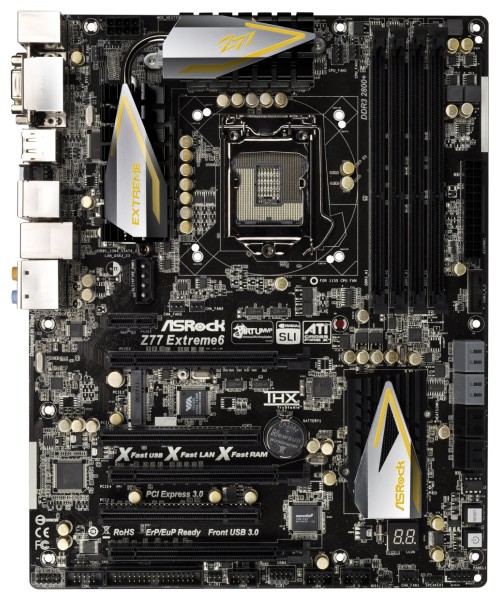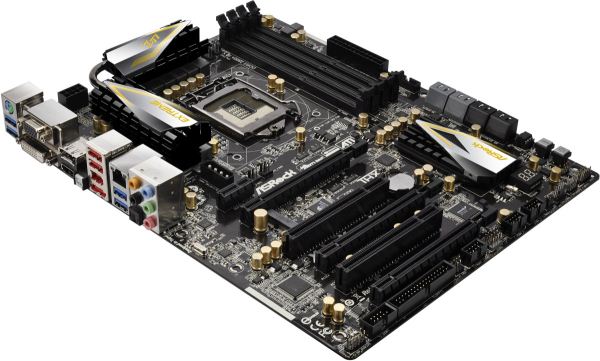Intel Z77 Panther Point Chipset and Motherboard Preview – ASRock, ASUS, Gigabyte, MSI, ECS and Biostar
by Ian Cutress on April 8, 2012 12:00 AM EST- Posted in
- Motherboards
- Intel
- Biostar
- MSI
- Gigabyte
- ASRock
- Asus
- Ivy Bridge
- ECS
- Z77
ASRock Z77 Extreme6—Visual Inspection
With the Extreme6, compared to the Extreme4, there are a significant number of changes, both visual and in terms of features. For a start, the heatsink design is more pronounced, using something similar to their X79 range in terms of black and gold ridged and edged surfaces. The VRM heatsink design is more substantial than the Extreme4, even though online it states it is still only an 8 + 4 VRM design—actually looking at the board, it seems more of a 10 + 4 design.
By looking at the motherboard, you would assume that it would support three-GPU setups. Unfortunately, this third full-length PCIe lane is only PCIe 2.0 x4, rather than splitting up the PCIe 3.0 lanes x8/x4/x4 or using a PLX chip. The MSRP for this board should be around $177, indicating that perhaps that is too cheap a board for one of the expensive PCIe 3.0 expansion PLX chips.

Onboard is also an mSATA port, right in the middle between the first PCIe slot and the PCI slot. Above the PCIe slots is a 4-pin molex power connector to provide extra power to the PCIe slots, although I am kind of getting tired of seeing it put in this location. If anything, it should be at the bottom end or beside the 24-pin power connector, as having it above the PCIe slots just means that there will be cables all over the place.
One other less obvious change to the Extreme4 is that there is a Floppy drive header on board. Yes, you heard me right—floppy drive! It seems odd now to include this legacy connection. It still has a place in industrial concepts (where a machine uses floppy drives and costs 1000x more than the PC processing its data), but not particularly on a higher end product which may be geared towards gaming and overclocking. Perhaps if ASRock are the only ones, then it creates a niche just for them.
In terms of fan headers on board, we have one three-pin beside the 8-pin 12V power connector, two CPU headers (one 4-pin, one 3-pin) just to the right of the top heatsink, two chassis three-pin headers beside the molex connector, and another 4-pin chassis header on the bottom of the board. On the right hand side, the USB 3.0 connector has been placed beneath the 24-pin ATX power connector, followed by the SATA ports. Like the Extreme4, we have the PCH SATA ports (two SATA 6 Gbps and four SATA 3 Gbps) and two extra SATA 6 Gbps from an ASMedia ASM1061 controller.
Around the larger chipset heatsink, we have power/reset buttons and a two digit debug display, both of which I personally like to see as a reviewer (makes my job a bit easier) but also helps overclockers. On the south side of the board, apart from that floppy connector I mentioned, we have a COM port, front panel audio, and an array of USB 2.0 headers.
PCIe layout is similar to the Extreme6, with a PCIe x1, PCIe 3.0 x16/x8, an mSATA connector, PCI, PCIe 3.0 x8, PCI, and a PCI 2.0 x4. This allows a user to use a dual GPU setup, and still have access to a PCIe x1 and x4.

Aside from the bowed picture from ASRock, we have something similar to the Extreme4 for the IO back panel, though this time with a DisplayPort output. From left to right, we have a combination PS/2 port, two USB 3.0 ports (blue), a D-Sub port, DVI-D, DisplayPort, HDMI, a ClearCMOS button, two USB 2.0 (red), an IEEE1394 port, eSATA, gigabit Ethernet, two more USB 3.0 (blue), and audio outputs including an optical SPDIF.
Board Features
| ASRock Z77 Extreme6 | |
| Size | ATX |
| CPU Interface | LGA-1155 |
| Chipset | Intel Z77 |
| Power Delivery | 8 + 4 |
| Memory Slots |
Four DDR3 DIMM slots supporting up to 32 GB Up to Dual Channel, 1066-2800 MHz |
| Video Outputs | DisplayPort, HDMI 1.4a, DVI-D, D-Sub |
| Onboard LAN | Broadcom BCM57781 |
| Onboard Audio | Realtek ALC898 |
| Expansion Slots |
2 x PCIe x16 Gen3 (x16, x8/8) 1 x PCIe x16 Gen2 (x4) 1 x PCIe x1 Gen2 2 x PCI 1 x mini PCIe |
| Onboard SATA/RAID |
2 x SATA 6 Gbps (PCH), Support for RAID 0, 1, 5, 10 2 x SATA 6 Gbps (ASMedia ASM1061) 4 x SATA 3 Gbps (PCH), Support for RAID 0, 1, 5, 10 |
| USB |
Two USB 3.0 at rear (PCH) Two USB 3.0 at rear (Etron EJ168A) One USB 3.0 header (PCH) |
| Onboard |
4 x SATA 6 Gbps 4 x SATA 3 Gbps 1 x Floppy Connector 1 x IR Header 1 x CIR Header 1 x COM Header 1 x SPDIF Header 1 x 4-pin Molex power connector Power/Reset Buttons Two Digit Debug LED 6 x Fan Headers Front panel audio connector 3 x USB 2.0 headers (support 6 USB 2.0 ports) 1 x USB 3.0 header (supports 2 USB 3.0 ports) |
| Power Connectors |
1 x 24-pin ATX connector 1 x 8-pin 12V connector 1 x 4-pin Molex for PCIe |
| Fan Headers |
2 x CPU Fan Header (one 4-pin, one 3-pin) 3 x CHA Fan Headers (one 4-pin, two 3-pin) 1 x SYS Fan Header (one 3-pin) |
| IO Panel |
1 x Combo PS/2 Port 1 x DisplayPort 1 x HDMI 1.4a 1 x DVI-D 1 x D-Sub 1 x Optical SPDIF 2 x USB 2.0 4 x USB 3.0 1 x IEEE1394 1 x Gigabit Ethernet 1 x Clear CMOS Audio Outputs |
| Warranty Period | 3 years from date of purchase |
| Product Page | Link |
Nothing immediately jumps out from the board features list aside from the differences to the Extreme4. This is a quite good package for an MSRP of $171.











145 Comments
View All Comments
t4murphy - Wednesday, April 18, 2012 - link
That was a good cpu for me before I went to the 920. I still ran MS FS9 with good results along with my GTX 8800. Im not laughing:)rocknrob - Thursday, April 12, 2012 - link
I had a 920 X58 setup and decided to rebuild to an i7 2700K Z68. So far I've regretted the whole thing. I'm going to pick up one of these ASUS Z77 Deluxe boards but I don't think it's going to make a big difference.The X58's/i7's were rock solid and performance monsters. I honestly see very little in terms of performance gains. Supposedly Ive Bridge processors are only going to give you about 15% to 20% increase in performance. If that's the case I think I'm going to stick with the 2700K until the next architecture change.
457R4LDR34DKN07 - Sunday, April 8, 2012 - link
you need to get a asus P8Z77-I DELUXE review.Mitxplease - Sunday, April 8, 2012 - link
Hells yes.GreenEnergy - Sunday, April 8, 2012 - link
I only found one (tiny) review sofar:http://vr-zone.com/articles/first-look-asus-p8z77-...
457R4LDR34DKN07 - Wednesday, April 11, 2012 - link
I actually would like a comparison with ZOTAC Z77-ITX WiFi, as I'm leaning toward the zotac mobo due to the msata compatibility by removing the wifi/bt module.ViperV990 - Sunday, April 8, 2012 - link
Does the Virtu MVP stuff work with an Eyefinity or NV Surround setup?martinw89 - Sunday, April 8, 2012 - link
I'm very curious about this too. On page two, Ian says "Within the hybrid system, the integrated GPU takes over two of the tasks for the GPU – snooping for required frames, and display output. This requires a system to run in i-Mode, where the display is connected to the integrated GPU."But on page 3, Lucid's own slide makes it sound like these new features are monitor configuration independent: http://images.anandtech.com/doci/5728/Lucid1.png
This is a super interesting feature, and I hope it performs as well in reality as it sounds like on paper. And with a triple screen setup it would be bliss.
jimnicoloff - Sunday, April 8, 2012 - link
I have a three monitor setup working just fine on a Z68 board with all monitors attached to a 6970. Virtu gives the option of which you want to be primary - the video card or the integrated graphics. So for me (with the video card primary) this works kind of backwards from a power saving point, but good for performance since it still allows for quick sync video transcoding, etc.I know this doesn't adress the new Virtu MVP, but I can't see them taking a step backwards when something similar works on the old version. Especially since if you are running in eyefinity mode it is just seen by the system as one big wide monitor and not three separate screens that each get their own render. Hopefully they can pull it off because I like my three screen setup and would hate to lose features because of that.
Zoomer - Tuesday, April 10, 2012 - link
I'm leading no:"This requires a system to run in <b>i-Mode, where the display is connected to the integrated GPU.</b>"